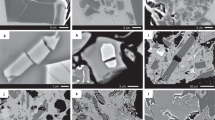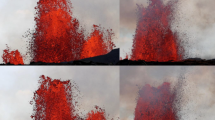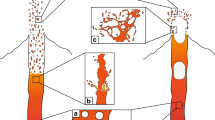Abstract
The fragmentation of bubbly magma is a defining point in a volcanic eruption—before fragmentation the magma flows relatively slowly, during fragmentation the bubbles break up to release compressed gas and, afterwards, the eruption becomes a violent gas flow carrying suspended magma particles. Seemingly benign lava flows or domes can suddenly fragment into deadly pyroclastic flows1,2,3. Several criteria have been proposed to define the point of magma fragmentation or foam stability4,5,6,7. The criterion of Papale7 is based on melt relaxation theory and equates magma strain rate with the rate of increase of flow velocity with distance. It ignores, however, the role of bubble pressure in causing fragmentation. Two empirical approaches4,5 consider the role of high bubble pressure in causing fragmentation but do not address the underlying physics of magma fragmentation. Here I develop a fragmentation criterion for bubbly magma based on brittle failure theory and apply it to the fragmentation of lava domes and flows. On the basis of this theory, a bubbly magma will fragment when the tensile stress at the inner walls of bubbles exceeds the tensile strength of the magma. The fragmentation conditions depend strongly on initial water content, with calculated vesicularity and final water levels coinciding reasonably well with those in observed pumices. This suggests that the proposed criterion captures the essence of the fragmentation process in bubbly magma.
This is a preview of subscription content, access via your institution
Access options
Subscribe to this journal
Receive 51 print issues and online access
$199.00 per year
only $3.90 per issue
Buy this article
- Purchase on Springer Link
- Instant access to full article PDF
Prices may be subject to local taxes which are calculated during checkout


Similar content being viewed by others
References
Sato,H., Fujii,T. & Nakada,S. Crumbling of dacite dome lava and generation of pyroclastic flows at Unzen volcano. Nature 360, 664–666 (1992).
Fink,J. H. & Kieffer,S. W. Estimate of pyroclastic flow velocities resulting from explosive decompression of lava domes. Nature 363, 612–615 (1993).
Navon,O., Chekhmir,A. & Lyakhovsky,V. Bubble growth in highly viscous melts: theory, experiments, and autoexplosivity of dome lavas. Earth Planet. Sci. Lett. 160, 763–776 (1998).
McBirney,A. R. & Murase,T. Factors governing the formation of pyroclastic rocks. Bull. Volcanol. 34, 372–384 (1970).
Alidibirov,M. A. A model for viscous magma fragmentation during volcanic blasts. Bull. Volcanol. 56, 459–465 (1994).
Proussevitch,A. A., Sahagian,D. L. & Kutolin,V. A. Stability of foams in silicate melts. J. Volcanol. Geotherm. Res. 59, 161–178 (1993).
Papale,P. Strain-induced magma fragmentation in explosive eruptions. Nature 397, 425–428 (1999).
Den Hartog,J. P. Strength of Materials (Dover, New York, 1977).
Lawn,B. Fracture of Brittle Solids (Cambridge University Press, 1993).
Zhang,Y. Mechanical and phase equilibria in inclusion-host systems. Earth Planet. Sci. Lett. 157, 209–222 (1998).
Proussevitch,A. A., Sahagian,D. L. & Anderson,A. T. Dynamics of diffusive bubble growth in magmas: Isothermal case. J. Geophys. Res. 98, 22283–22307 (1993).
Proussevitch,A. A. & Sahagian,D. L. Dynamics and energetics of bubble growth in magmas: Analytical formulation and numerical modeling. J. Geophys. Res. 103, 18223–18251 (1998).
Webb,S. L. & Dingwell,D. B. Non-Newtonian rheology of igneous melts at high stresses and strain rates: experimental results for rhyolite, andesite, basalt, and nephelinite. J. Geophys. Res. 95, 15695–15701 (1990).
Romano,C., Mungall,J. E., Sharp,T. & Dingwell,D. B. Tensile strengths of hydrous vesicular glasses: An experimental study. Am. Mineral. 81, 1148–1154 (1996).
Alidibirov,M. & Dingwell,D. B. Magma fragmentation by rapid decomposition. Nature 380, 146–148 (1996).
Liu,Y., Zhang,Y. & Sohn,J. Bubble growth in natural rhyolitic glasses. Eos 79, F1013 (1998).
Zhang,Y. H2O in rhyolitic glasses and melts: measurement, speciation, solubility, and diffusion. Rev. Geophys. 37, 493–516 (1999).
Hess,K. & Dingwell,D. B. Viscosities of hydrous leucogranitic melts: A non-Arrhenian model. Am. Mineral. 81, 1297–1300 (1996).
Zhang,Y., Sturtevant, B. & Stolper,E. M. Dynamics of gas-driven eruptions: Experimental simulations using CO2-H2O-polymer system. J. Geophys. Res. 102, 3077–3096 (1997).
Zhang,Y. Experimental simulations of gas-driven eruptions: kinetics of bubble growth and effect of geometry. Bull. Volcanol. 59, 281–290 (1998).
Acknowledgements
This research is supported by the US NSF. I thank A. A. Proussevitch for making the bubble growth program available, J. R. Barber for discussion on brittle failure, Y. Liu for calculation of some bubble growth curves, and D. Snyder and P. Papale for comments.
Author information
Authors and Affiliations
Rights and permissions
About this article
Cite this article
Zhang, Y. A criterion for the fragmentation of bubbly magma based on brittle failure theory. Nature 402, 648–650 (1999). https://doi.org/10.1038/45210
Received:
Accepted:
Issue Date:
DOI: https://doi.org/10.1038/45210
This article is cited by
-
In situ observation of glass-like fragmentation of high-temperature silicate melts generating fine ashes
Communications Earth & Environment (2023)
-
Shallow storage, fragmentation depth, and eruption velocity of the 7.05 Ma Rattlesnake Tuff as indicated by breadcrust bubble ash morphology
Bulletin of Volcanology (2023)
-
Are volcanic melts less viscous than we thought? The case of Stromboli basalt
Contributions to Mineralogy and Petrology (2023)
-
Rheology of nanocrystal-bearing andesite magma and its roles in explosive volcanism
Communications Earth & Environment (2022)
-
High CO2 content in magmas of the explosive andesitic Enco eruption of Mocho-Choshuenco volcano (Chile)
Bulletin of Volcanology (2022)
Comments
By submitting a comment you agree to abide by our Terms and Community Guidelines. If you find something abusive or that does not comply with our terms or guidelines please flag it as inappropriate.



